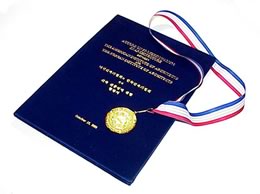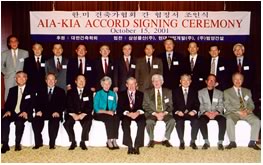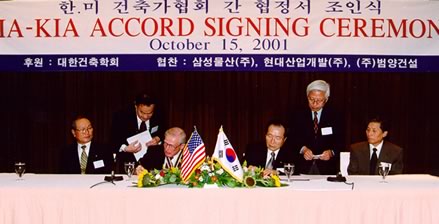
The Korean Institute of Architects' first honorary fellow shares his impressions

AIA President
AIA President John D. Anderson, FAIA, HFKIA, recently embarked on a whirlwind visit to the Far East, during which he took part in the annual Japan Institute of Architects convention in Tokyo. From the Land of the Rising Sun, Anderson crossed the China Sea to visit South Korea, where he was pleased to sign the Accord on Professionalism in Architecture between the AIA and the Korean Institute of Architects (KIA).
 At
the televised signing ceremony in Seoul on October 15, the KIA presented
Anderson with a great honor: they bestowed upon him their institute's
very first honorary fellow membership and its attendant medal.
At
the televised signing ceremony in Seoul on October 15, the KIA presented
Anderson with a great honor: they bestowed upon him their institute's
very first honorary fellow membership and its attendant medal.
Following are Anderson's thoughts on the highlights of his trip.
We had a delightful start to our trip in Tokyo, where members of the Japan Institute of Architects served as our architectural tour guides, and showed us every form of building you could imagine, from ancient temples to modern skyscrapers. Then my wife, Flodie, and I took a side trip Kyoto for a few days of vacation. We were fortunate to stay at a 17th century inn where we experienced the traditional grace and beauty of Japanese living space and service. We ate our meals seated in traditional Japanese style on the floor and enjoyed ceremonial teas. Perhaps best of all, the space we stayed in was beautiful, complete with a private porch and garden.
Response to September
11
We returned to Japan for a press conference that was held in conjunction
with the annual combined Japan Institute of Architects/AIA meeting. The
Japanese press was very concerned about reaction to the September 11 terrorist
attacks, especially about actions the U.S. is undertaking in response.
They also were interested in the possibilities for building anew on the
World Trade Center site.
Architecture associations from 30 countries sent us notes of condolence after the attacks; many also inquired about what they could do to help. The AIA responded by recommending—in accordance with AIA New York's wishes—that contributions should be sent to the World Trade Center Memorial Fund. Japan was the first foreign country to respond, and representatives from the JIA told us proudly that they had set up a fund internally to collect money from their members to contribute to the memorial fund.
Many shared interests
and concerns
The next morning we flew to Kanazawa, which is home to many cultural treasures.
We took part in the JIA's two-day conference of 500 people—and had
a great time. The meeting took place in a renovated spinning mill, now
converted to a conference center. It is symbolic of how simpler industries—such
as spinning—are being wiped out in Japan by other Asian countries
where the cost of labor is much lower.
I spoke at the wrap-up session and thanked the members of the JIA for their good wishes. I spoke about the terrorist attacks and their ramifications. There were a lot of other issues on the table, many covered in technical sessions and many in which we share an interest, foremost, professional practice and sustainability issues. The Japanese also are very concerned about sprawl, especially in Tokyo. The difference is theirs is a very dense, urban sprawl as opposed to our suburban sprawl. Their infrastructure also is a concern; it is stretched thin. Nonetheless, they have great surface transportation, including their "bullet train" that travels at 160 miles per hour and provides a very comfortable ride. Security overall was distinctly present but not overwhelming; we were, however, carefully screened at the airport.
Korea has pride in
its architecture
From Kanazawa, we drove 40 miles down the coast to catch our flight to
Seoul. Korea is a place distinctly divided, with poverty to the north
and wealth to the south. It's a beautiful country; I didn't know until
I saw it how heavily forested it is. There are 20 million people living
in and around Seoul; that's half of South Korea's population.
South Korea was under Japanese control until 1945 and was under harsh leadership for some time after that. In the last 20 years, however, South Korea has seen an explosion of development—they have reinvented themselves as a people. They are a proud and very civil people with amazing energy, and it shows in their architecture.
 The
Korean Institute of Architects (KIA) and their President Il-in Hwang hosted
a fantastic ceremony that centered on the signing of the accord between
their institute and the AIA. Goh Kun. The mayor of Seoul, and Namkung
Jin, the minister of culture and tourism, whose purview includes promoting
all of the arts, including architecture, took part in the televised ceremony.
It began with a moment of silence for those affected by the September
11 terrorist attacks. Prior to the ceremony, I was privileged to have
a real and meaningful conversation, in spite of the awkwardness of working
through an interpreter, with the Minister Namkung, who possesses a deep
understanding of architecture.
The
Korean Institute of Architects (KIA) and their President Il-in Hwang hosted
a fantastic ceremony that centered on the signing of the accord between
their institute and the AIA. Goh Kun. The mayor of Seoul, and Namkung
Jin, the minister of culture and tourism, whose purview includes promoting
all of the arts, including architecture, took part in the televised ceremony.
It began with a moment of silence for those affected by the September
11 terrorist attacks. Prior to the ceremony, I was privileged to have
a real and meaningful conversation, in spite of the awkwardness of working
through an interpreter, with the Minister Namkung, who possesses a deep
understanding of architecture.
A solid foundation
for a great future
We also had a tour of Seoul architecture during our visit. I had heard
rumors that many of the new structures were put up in a hurry, but the
work I saw was wonderful—well detailed and finely crafted. Most of
the components were Korean-made. Most of the buildings were designed by
Korean architects—the country has many fine architects—and some
were designed in partnership with American architects. The other distinguished
AIA member guests on this tour: Leonard Parker, FAIA, and Stephan Huh,
FAIA, of Minneapolis' Leonard Parker Associates, and Ki Suh Park, FAIA,
of LA's Gruen Associates, can attest to this.
Both Japan and South Korea are experiencing an economic slowdown. It is South Korea's first downturn since they began this current development push 20 years ago. I think that their exuberant "extra energy" is transmuting into an optimism that will help carry them through. I predict their energy and intellect will make them a powerful presence and wonderful allies. As the representative of the AIA, I was proud to tell them, "The choice of the word 'accord' to describe what we are ratifying tonight is no accident. The root of the word is derived from the ancient Latin word for heart—'cord.' The commitment made in this document to you, our Korean friends and colleagues, comes from the heart. And it is with a glad heart that I now sign it."

AIA,
KIA Sign Accord on Professionalism in Architecture
Korean Institute of Architects President Il-in Hwang and AIA President
John D. Anderson, FAIA, HFKIA, signed an accord October 15, acknowledging
and defining the role of their architectural societies in promoting professionalism,
namely in the practice of architecture, architecture education, registration,
and licensing. The accord affirms clearly the desire of the two societies
to "promote understanding and fellowship between architects in the
Republic of Korea and the United States of America."
The accord is based on, and references, the "Accord on Recommended International Standards of Professionalism in Architectural Practice" adopted by the International Union of Architects (UIA) in June 1999. It confirms support for and promises participation in the activities of the UIA.
In particular, the accord states that the KIA and the AIA will seek for ways to enhance continuing professional development and the AIA CES (Continuing Education System) for members of both societies. The two societies also will exchange information on professional ethics, practice, professional examination, electronic communications, and practice. They also hope to exchange delegates, architectural exhibits, and articles for publication.
In addition, the accord acknowledges that both groups agree to advise their respective governments on market access and provision of architectural services, and "recognize that environmental quality, consumer protection, and public safety, health and welfare require support through legislative backing and professional standards of design and practice."
To read the full text of the accord, click here.
Copyright 2001 The American Institute of Architects. All rights reserved.
![]()
|
|
|